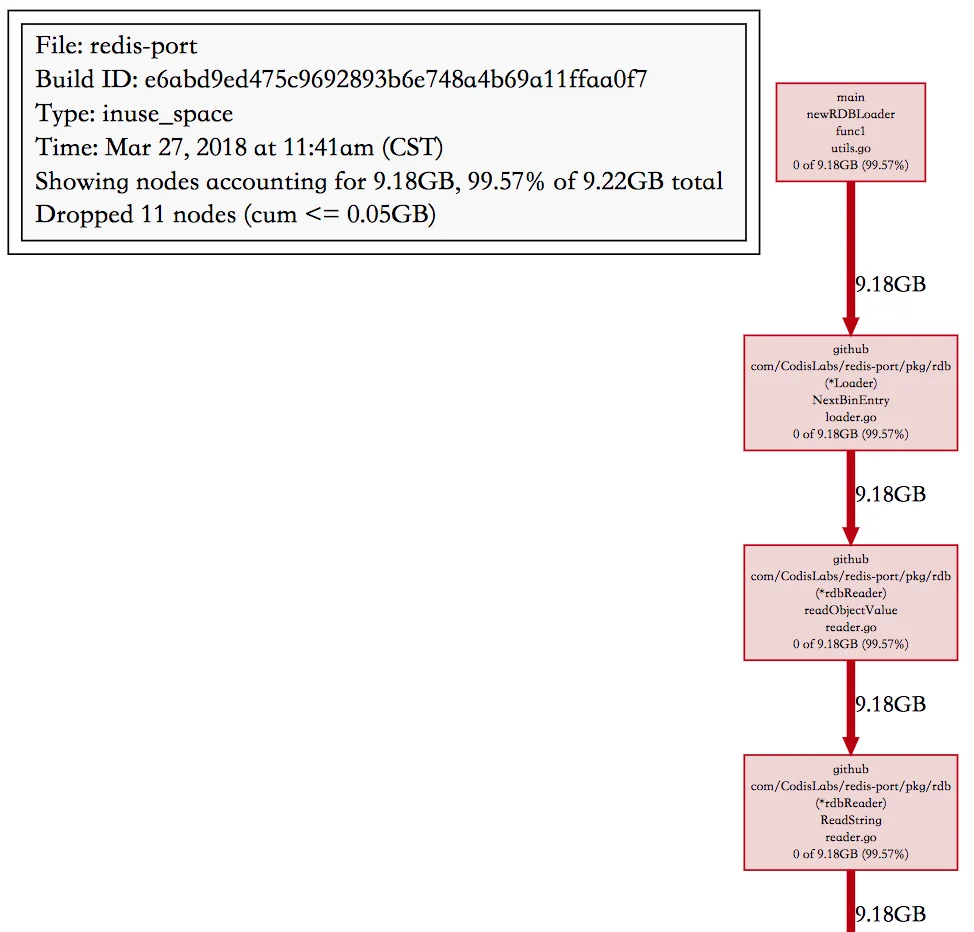1. 背景
redis-portredis-portOOM10G4.5GB2. 分析
2.1 GCTRACE
GODEBUG='gctrace=1'gc loggc 21 @8.389s 0%: 0.069+4.0+0.16 ms clock, 1.6+2.8/14/10+4.0 ms cpu, 87->88->45 MB, 89 MB goal, 24 P
gc 22 @8.919s 0%: 0.053+3.7+0.63 ms clock, 1.0+1.9/16/12+12 ms cpu, 87->88->44 MB, 90 MB goal, 24 P
gc 23 @9.431s 0%: 0.055+3.9+0.18 ms clock, 1.3+2.6/15/13+4.5 ms cpu, 87->88->45 MB, 89 MB goal, 24 P
gc 24 @9.948s 0%: 0.093+6.0+1.1 ms clock, 2.2+2.3/18/5.6+27 ms cpu, 87->88->44 MB, 90 MB goal, 24 P
gc 25 @10.108s 0%: 0.026+10+0.55 ms clock, 0.63+0/12/15+13 ms cpu, 88->89->66 MB, 89 MB goal, 24 P
gc 26 @10.407s 0%: 0.023+23+0.57 ms clock, 0.56+0/41/3.3+13 ms cpu, 178->178->133 MB, 179 MB goal, 24 P
gc 27 @10.792s 0%: 0.024+45+0.58 ms clock, 0.58+0/63/2.5+14 ms cpu, 282->282->222 MB, 283 MB goal, 24 P
gc 28 @11.560s 0%: 0.023+92+0.13 ms clock, 0.55+0/17/100+3.1 ms cpu, 520->520->399 MB, 521 MB goal, 24 P
gc 29 @13.113s 0%: 0.035+186+0.53 ms clock, 0.85+0/21/187+12 ms cpu, 997->997->755 MB, 998 MB goal, 24 P
gc 30 @14.490s 0%: 0.035+9.2+0.55 ms clock, 0.84+0.20/18/3.0+13 ms cpu, 858->858->518 MB, 1510 MB goal, 24 P
gc 31 @16.208s 0%: 0.032+381+0.15 ms clock, 0.77+0/400/3.5+3.7 ms cpu, 1610->1610->1466 MB, 1611 MB goal, 24 P
gc 32 @16.841s 0%: 0.024+9.6+0.12 ms clock, 0.59+0.12/15/6.7+3.0 ms cpu, 1488->1489->993 MB, 2932 MB goal, 24 P
gc 33 @22.381s 0%: 0.026+752+0.14 ms clock, 0.64+0/18/760+3.3 ms cpu, 3358->3359->2888 MB, 3359 MB goal, 24 P
gc 34 @23.237s 0%: 0.020+7.7+0.12 ms clock, 0.49+0.14/17/2.0+2.9 ms cpu, 2889->2889->1940 MB, 5776 MB goal, 24 P
gc 35 @34.475s 0%: 0.032+9.9+0.11 ms clock, 0.77+0.65/17/9.3+2.7 ms cpu, 2910->2910->1940 MB, 3881 MB goal, 24 P
gc 36 @34.732s 0%: 0.025+1412+0.13 ms clock, 0.60+0/1422/10+3.2 ms cpu, 5746->5746->5732 MB, 5747 MB goal, 24 P
gc 37 @54.129s 0%: 0.028+9.9+0.12 ms clock, 0.67+0.95/18/11+3.0 ms cpu, 7274->7274->3836 MB, 11464 MB goal, 24 P
gc 38 @59.297s 0%: 0.032+2910+0.13 ms clock, 0.78+0/2920/13+3.2 ms cpu, 11847->11847->11420 MB, 11848 MB goal, 24 P
gc 39 @64.199s 02010.046+29024+0.32 ms clock, 1.1+0/18/3195+7.7 ms cpu, 15532->15532->11577 MB, 22840 MB goal, 24 P第几次gc程序启动经历的时间#->#-># MB heap size at GC start, at GC end, and live heap
# MB goal goal heap size (这个解释一下,每次gc circle完,gc会根据当前分配的堆内存大小和GOGC环境变量,计算下一次gc的目标内存大小,如果后面内存使用没有超过这个goal,gc不会用力太猛)Golang pprof2.2 Golang pprof
Golang pprof我们在程序中嵌入如下几行代码,
import _ "net/http/pprof"
go func() {
http.ListenAndServe("0.0.0.0:8899", nil)
}()http://ip:8899/debug/pprof//debug/pprof/
profiles:
0 block
32 goroutine
552 heap
0 mutex
51 threadcreate
full goroutine stack dumpheapheap profile: 96: 1582948832 [21847: 15682528480] @ heap/1048576
91: 1527472128 [246: 4129210368] @ 0x471d87 0x471611 0x4718cd 0x4689bf 0x50deb9 0x50d7ac 0x75893b 0x45d801
# 0x471d86 bytes.makeSlice+0x76 /usr/local/go/src/bytes/buffer.go:231
# 0x471610 bytes.(*Buffer).grow+0x140 /usr/local/go/src/bytes/buffer.go:133
# 0x4718cc bytes.(*Buffer).Write+0xdc /usr/local/go/src/bytes/buffer.go:163
# 0x4689be io.(*multiWriter).Write+0x8e /usr/local/go/src/io/multi.go:60
# 0x50deb8 github.com/CodisLabs/redis-port/pkg/rdb.createValueDump+0x198 go_workspace/src/github.com/CodisLabs/redis-port/pkg/rdb/loader.go:194
# 0x50d7ab github.com/CodisLabs/redis-port/pkg/rdb.(*Loader).NextBinEntry+0x28b go_workspace/src/github.com/CodisLabs/redis-port/pkg/rdb/loader.go:176
# 0x75893a main.newRDBLoader.func1+0x23a go_workspace/src/github.com/CodisLabs/redis-port/cmd/utils.go:733
......包括一些汇总信息,和各个go routine的内存开销,不过这里除了第一行信息比较直观,其他的信息太离散。可以看到当前使用的堆内存是1.58GB,总共分配过15.6GB。
heap profile: 96(inused_objects): 1582948832(inused_bytes) [21847(allocated_objects): 15682528480(allocted_bytes)] @ heap/1048576go tool pprofgo tool pprof -alloc_space/-inuse_space http://ip:8899/debug/pprof/heap这里有两个选项,-alloc_space和-inuse_space,从名字应该能看出二者的区别,不过条件允许的话,我们优先使用-inuse_space来分析,因为直接分析导致问题的现场比分析历史数据肯定要直观的多,一个函数alloc_space多不一定就代表它会导致进程的RSS高,因为我们比较幸运可以在线下复现这个OOM的场景,所以直接用-inuse_space。
gdbtopflat(pprof) top
Showing nodes accounting for 3.73GB, 99.78% of 3.74GB total
Dropped 5 nodes (cum <= 0.02GB)
Showing top 10 nodes out of 16
flat flat% sum% cum cum%
3.70GB 98.94% 98.94% 3.70GB 98.94% bytes.makeSlice /usr/local/go/src/bytes/buffer.go
0.03GB 0.83% 99.78% 0.03GB 0.83% main.(*cmdRestore).Main /usr/local/go/src/bufio/bufio.go
0 0% 99.78% 3.70GB 98.94% bytes.(*Buffer).Write /usr/local/go/src/bytes/buffer.go
0 0% 99.78% 3.70GB 98.94% bytes.(*Buffer).grow /usr/local/go/src/bytes/buffer.go
0 0% 99.78% 3.70GB 98.94% github.com/CodisLabs/redis-port/pkg/rdb.(*Loader).NextBinEntry go_workspace/src/github.com/CodisLabs/redis-port/pkg/rdb/loader.go
0 0% 99.78% 3.70GB 98.94% github.com/CodisLabs/redis-port/pkg/rdb.(*rdbReader).Read go_workspace/src/github.com/CodisLabs/redis-port/pkg/rdb/reader.go
0 0% 99.78% 3.70GB 98.94% github.com/CodisLabs/redis-port/pkg/rdb.(*rdbReader).ReadBytes go_workspace/src/github.com/CodisLabs/redis-port/pkg/rdb/reader.go
0 0% 99.78% 3.70GB 98.94% github.com/CodisLabs/redis-port/pkg/rdb.(*rdbReader).ReadString go_workspace/src/github.com/CodisLabs/redis-port/pkg/rdb/reader.go
0 0% 99.78% 3.70GB 98.94% github.com/CodisLabs/redis-port/pkg/rdb.(*rdbReader).readFull go_workspace/src/github.com/CodisLabs/redis-port/pkg/rdb/reader.go
0 0% 99.78% 3.70GB 98.94% github.com/CodisLabs/redis-port/pkg/rdb.(*rdbReader).readObjectValue go_workspace/src/github.com/CodisLabs/redis-port/pkg/rdb/reader.go bytes.makeSlice(*Loader).NextBinEntrylist(pprof) list NextBinEntry
Total: 3.74GB
ROUTINE ======================== github.com/CodisLabs/redis-port/pkg/rdb.(*Loader).NextBinEntry in go_workspace/src/github.com/CodisLabs/redis-port/pkg/rdb/loader.go
0 3.70GB (flat, cum) 98.94% of Total
. . 137: default:
. . 138: key, err := l.ReadString()
. . 139: if err != nil {
. . 140: return nil, err
. . 141: }
. 3.70GB 142: val, err := l.readObjectValue(t)
. . 143: if err != nil {
. . 144: return nil, err
. . 145: }
. . 146: entry.DB = l.db
. . 147: entry.Key = key
可以直接看到这个函数在哪一行代码产生了多少的内存!不过如果是在可以方便导出文件的测试环境,推荐使用命令,
go tool pprof -inuse_space -cum -svg http://ip:8899/debug/pprof/heap > heap_inuse.svg
这个可以得到前后调用关系的调用栈图,同时还包括每一层的inuse 内存大小,文件名,函数,到下一层的内存大小,分析起来简直不能再顺手。
bytes.Buffergrow// grow grows the buffer to guarantee space for n more bytes.
// It returns the index where bytes should be written.
// If the buffer can't grow it will panic with ErrTooLarge.
func (b *Buffer) grow(n int) int {
......
} else {
// Not enough space anywhere, we need to allocate.
buf := makeSlice(2*cap(b.buf) + n)
copy(buf, b.buf[b.off:])
b.buf = buf
}
......
}Buffer在空间不够时,申请一个当前空间2倍的byte数组,然后把老的copy到这里,这个峰值内存就是3倍的开销,如果value大小5GB,读到4GB空间不够,那么创建一个8GB的新buffer,那么峰值就是12GB了,此外Buffer的初始大小是64字节,在增长到4GB的过程中也会创建很多的临时byte数组,gc不及时也是额外的内存开销,所以4.5GB的RDB,在有大key的情况下,峰值内存用到15GB也就可以理解了。
- Fix
这个问题的根本原因还是按key处理一次读的value太大,在碰到hash这种复杂数据类型时,其实我们可以分而治之,读了一部分value后,比如16MB就生成一个子hash,避免Buffer grow产生太大的临时对象。
此外,解析RDB时,受限于RDB的格式,只能单个go routine处理,但是回放时,是可以由多个go routine来并发处理多个子hash,写到目标实例的。每个子hash处理完,又可以被gc及时的清理掉。同时并发度上去了,同步的速度也有所提升(主要受限于目标Redis,因为Redis是单线程处理请求)。


2.6GB80%